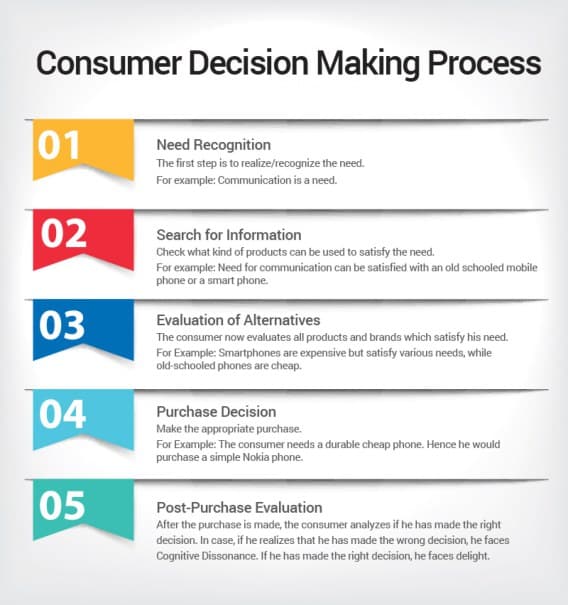Deciphering the consumer decision-making process unveils a complex web of choices, influences, and factors that shape how individuals make purchasing decisions. Understanding this intricate system is paramount in navigating the world of marketing successfully. From initial problem recognition to post-purchase evaluation, consumers embark on a journey guided by emotions, information, and external stimuli. In this exploration, we will delve deep into the intricacies of the consumer decision-making process, shedding light on the psychology, behaviors, and mechanisms that drive individuals to choose one product over another. Stay tuned for a comprehensive analysis that will equip you with insights to decode and influence consumer decisions effectively.
Decoding the Consumer Decision Making Process
What is Consumer Decision Making?
Consumer decision making is the process by which individuals select, purchase, use, and dispose of goods and services. This process involves a series of steps that consumers go through, often subconsciously, to make choices that satisfy their needs and desires. Each decision is influenced by an array of factors including personal preferences, cultural norms, social pressures, and economic considerations.
At the heart of consumer decision making lies the recognition of a need or a problem. Once a consumer realizes a gap between their current situation and a desired state, they embark on a search for information to bridge this gap. They evaluate alternatives based on this information and their own criteria, make a purchase decision, and reflect on their satisfaction post-purchase, which then influences future decisions.
Understanding this process is fundamental for businesses aiming to connect with their target market and to influence consumer behavior in their favor.

Identifying the Stages in the Consumer’s Decision Journey
The consumer’s decision journey consists of a few key stages. It begins with problem recognition, where the consumer perceives a need or identifies a problem that requires solving. This leads to information search, where consumers seek out data relevant to their decision, often leveraging both online resources and personal experiences.
Subsequently, the evaluation of alternatives takes place, with consumers considering different products or services that could fulfill their needs. This is followed by the purchase decision, a critical point where the consumer decides on the product to buy based on the information and comparisons made.
After the purchase, the consumer experiences the post-purchase evaluation phase. Here, they assess whether the product has met their expectations. Their level of satisfaction or dissatisfaction at this stage will heavily influence their future purchasing decisions and loyalty to a brand.
Understanding these stages is vital for marketers aiming to guide consumers through their decision-making journey.
The Psychological Dynamics behind Consumer Decisions
The psychological dynamics of consumer decisions are rooted in cognitive and emotional factors that drive purchasing behaviors. Cognitive psychology examines how consumers process information, including how they perceive, think, remember, and learn. For instance, consumers often use heuristics or mental shortcuts to make decisions more efficiently, which can be influenced by branding and marketing efforts.
Emotions also play a crucial role in decision making. Positive emotions can increase the likelihood of a purchase, while negative emotions might deter it. Moreover, factors like social proof, where consumers are influenced by the choices of others, and the concept of perceived risk, involving the potential negative outcomes of a purchase, play into the complex web of consumer psychology.
Marketers who understand these psychological dynamics can craft strategies that align with consumer mindsets, effectively swaying the decision-making process toward their products or services.
Understanding Consumer Behavior
The Influential Role of Personal Factors
Personal factors greatly influence consumer behavior, shaping how individuals perceive and interact with the marketplace. These factors include demographic elements such as age, gender, income, and education, which can determine purchasing power and preferences. Lifestyle, a person’s interests, activities, and opinions, also dictates the type of products they are likely to buy.
Personality traits and self-concept are integral as well; for example, someone who sees themselves as innovative may be more inclined to try new products. Psychological drivers such as motivation and needs, whether physiological or psychological, prompt consumers to seek solutions through their purchases.
Marketers must consider these personal factors when tailoring their communication and product offerings. By aligning their strategies with the specific needs and characteristics of their target audience, businesses can increase the relevance and impact of their marketing efforts.
Cultural and Social Factors Affecting Consumer Decisions
Cultural and social factors are significant in shaping consumer behavior as they provide the framework within which individuals form their values and beliefs. Culture influences preferences, tastes, and consumption habits, often dictating the types of products that are favored or avoided within a community. Social factors, including family, reference groups, and social status, also affect decision-making. For instance, recommendations from family or friends can carry more weight than advertising.
Moreover, the role of social media has amplified the impact of social factors, with influencers and online communities playing a significant part in shaping consumer decisions. The need for social acceptance and conformity can lead consumers to make purchases that align with group norms.
Businesses must be mindful of these cultural and social dimensions to effectively reach and engage their audience, ensuring that their marketing strategies are culturally sensitive and socially attuned.
The Impact of Marketing and Branding on Consumer Choices
Marketing and branding are powerful tools that can significantly impact consumer choices. Effective marketing campaigns communicate the value and benefits of a product, creating awareness and interest. Branding goes further, fostering an emotional connection with the consumer and differentiating a product from its competitors. A strong brand can instill trust and loyalty, influencing not only the initial purchase decision but also long-term consumer behavior.
Moreover, branding shapes consumer perceptions through associations with quality, status, or lifestyle, which can be especially influential in saturated markets. Consistent and positive brand experiences reinforce these perceptions, leading to repeat purchases and recommendations.
Therefore, understanding the influence of marketing and branding is essential for businesses. They must carefully craft their messages and manage their brand’s reputation to align with consumer expectations and values, driving favorable decision-making outcomes.
Fine-Tuning Your Business Strategy
How In-depth Understanding Influences Business Strategies
An in-depth understanding of the consumer decision-making process allows businesses to fine-tune their strategies in a way that resonates deeply with their target audience. By comprehending the nuances of consumer behavior, companies can develop products and services that meet the specific needs and wants of their customers. This knowledge also guides the creation of more effective marketing campaigns that speak directly to the motivations and pain points of consumers.
Additionally, insights into consumer psychology can lead to enhanced customer experiences, both in-store and online, which are critical for building brand loyalty. Businesses can leverage this understanding to design touchpoints that positively influence the consumer journey at every stage.
In essence, the more a business understands its consumers, the better it can align its offerings and marketing efforts, resulting in a competitive edge and increased customer satisfaction.
Recognizing Consumer Needs for Tailored Solutions
Tailored solutions are at the core of an effective business strategy. Recognizing and addressing individual consumer needs not only enhances the customer experience but also builds a strong, loyal customer base. By collecting and analyzing data on consumer behavior, preferences, and feedback, businesses can identify patterns and unique requirements that may not be evident at the surface level.
This recognition enables companies to customize their offerings, whether through personalized marketing messages, bespoke products, or targeted services, to better meet the expectations of their consumers. Personalization has been shown to increase engagement, as customers feel understood and valued by the brand.
In addition, customized solutions can lead to a reduction in resources wasted on broad, ineffective strategies. By focusing on the specific needs of their consumer base, businesses can allocate their resources more efficiently, leading to higher returns on investment.
Techniques to Influence the Customer Decision Making Process
Influencing the customer decision-making process involves strategic techniques that guide consumers towards a desired outcome. One effective approach is creating a sense of urgency, such as limited-time offers or limited stock, which can motivate consumers to act quickly. Providing clear, concise information about the benefits and features of a product also helps consumers make informed decisions.
Social proof, such as customer testimonials and reviews, can alleviate concerns about product quality and increase trust. Reciprocity is another powerful tool; when a business offers something of value, like a free sample or a helpful guide, consumers may feel inclined to reciprocate by making a purchase.
Simplifying the buying process by reducing the number of steps or decisions a consumer must make can also lead to higher conversion rates. By employing these and other techniques, businesses can effectively steer consumer decisions and increase the likelihood of a sale.
The Future of Consumer Decision Making
The Role of Digital Transformation
Digital transformation is reshaping the future of consumer decision making by integrating technology into every aspect of the consumer journey. This shift to digital platforms allows for the collection and analysis of vast amounts of consumer data, enabling businesses to personalize experiences and predict future behaviors with greater accuracy.
The rise of artificial intelligence and machine learning is also playing a pivotal role, offering sophisticated insights and automating interactions through chatbots and recommendation engines. These tools enhance the decision-making process by providing timely, relevant information and personalized suggestions to consumers.
Moreover, digital transformation empowers consumers with more information and options than ever before, increasing competition and raising expectations for businesses. Companies that harness the power of digital transformation can create seamless, omnichannel experiences that cater to the modern consumer’s demand for convenience, speed, and efficiency.
The E-Commerce Revolution and Consumer Decisions
The e-commerce revolution has dramatically altered the landscape of consumer decision making. Consumers now enjoy the convenience of shopping from anywhere, at any time, with access to an international marketplace. This access has also led to increased transparency in pricing and availability, intensifying competition among sellers.
E-commerce platforms leverage data analytics to offer personalized shopping experiences, making recommendations based on past behavior, search patterns, and purchase history. This level of customization can significantly influence consumer decisions, leading to more spontaneous and frequent purchases.
Furthermore, social commerce, which integrates e-commerce with social media platforms, allows consumers to complete purchases directly through social media, streamlining the decision-making process. As e-commerce continues to evolve, its impact on how consumers make decisions will only grow, requiring businesses to adapt and innovate continuously to meet changing consumer needs.
The Future of Business: Catering to Evolved Consumer Decision Making
Businesses of the future must cater to an evolved consumer decision-making process that is increasingly driven by digital experiences and personalized interactions. To stay relevant, companies need to anticipate changes in consumer behavior and adapt their strategies accordingly. This involves integrating advanced technologies like AI and big data to not only understand consumer needs but also to predict future trends.
Sustainability and ethical considerations are becoming more influential in consumer decisions. Therefore, businesses must also commit to transparency and corporate social responsibility to align with consumer values. The brands that succeed will be those that offer authenticity, personalized experiences, and a seamless integration between the online and offline worlds.
As consumer decision-making becomes more complex, businesses must continue to innovate their approach, focusing on creating value and cultivating trust. Those that are agile and responsive to the evolving landscape will be best positioned to thrive.



![How Virtual and Augmented Reality will Influence Decision-Making [Infographic] | Guided Selling](https://www.guided-selling.org/wp-content/uploads/2016/06/generate_images_for_my_blog_post_post_title_is_-6.jpg)
